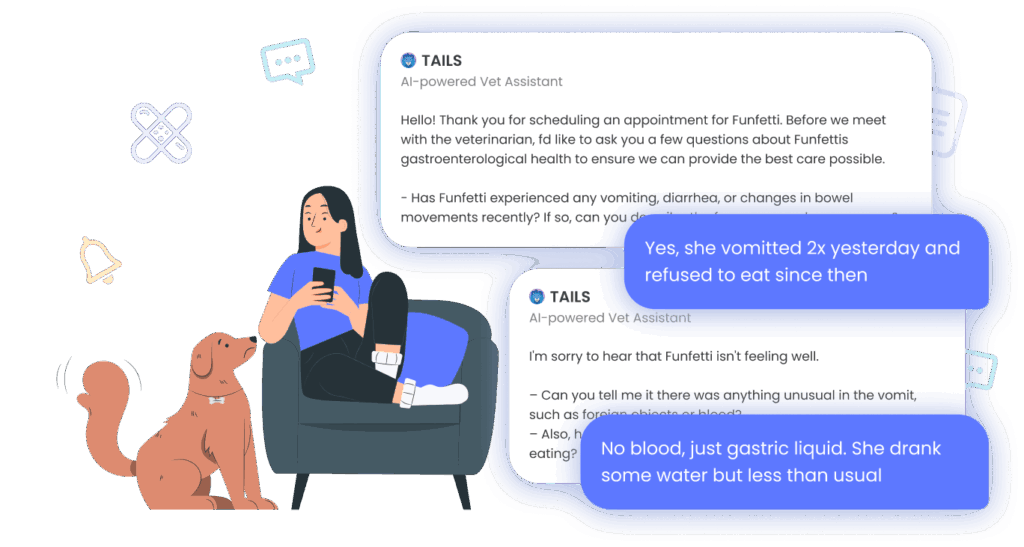
Automated Patient Intake Is the New Veterinary Standard
How much time does your front desk spend chasing down paperwork, deciphering handwriting, and manually re-typing client information into your PIMS? Ten minutes per patient? Twenty? Now multiply that by the number of appointments you have each day. The number gets big, fast.
That’s not just lost time, it’s a hidden tax on your clinic’s efficiency, accuracy, and client experience. While the world has moved on, many clinics remain tethered to the slow, clunky, and error-prone process of manual intake. But the clipboard-and-pen era is officially over. Automated patient intake isn’t a luxury, it’s the new standard.
The Cost of Outdated Intake Processes
Traditional patient intake creates bottlenecks that ripple throughout the entire clinic workflow.
- It Kills Efficiency
Every minute your staff spends on manual data entry is a minute they aren’t welcoming a patient, assisting a vet, or managing the appointment schedule. This administrative drag reduces your team’s capacity and forces them to multitask, leading to burnout and a chaotic front desk.
- It Breeds Errors
Illegible handwriting, missed fields, and typos are inevitable with manual entry. An incorrect phone number can lead to a missed follow-up call. A mistyped allergy could have serious consequences. These small errors erode the integrity of your patient records and create unnecessary risk.
- It Frustrates Clients
Modern consumers expect seamless digital experiences. Forcing them to juggle a clipboard, a pen, and a leash in a busy waiting room is a recipe for a poor first impression. The long waits and redundant questions that accompany manual intake only add to their stress, starting the visit on the wrong foot.
What Modern Patient Intake Looks Like
Today, forward-thinking clinics are adopting automated patient intake systems that streamline the process from the moment an appointment is booked. Clinics report reducing intake processing time by 60-80%, allowing them to see more patients without extending hours or adding staff.
Dr. Michelle Woodruff of Woodruff Vet Services estimates that automated intake saves 5-10 minutes per appointment—time that previously would have been spent gathering basic information.
Here’s what a modern, automated flow looks like:
- The process begins with sending smart, mobile-friendly forms that clients receive ahead of their visit. This flexibility allows pet owners to complete forms at their own pace, reducing wait times and eliminating the paper clutter that has long defined veterinary waiting rooms. These forms are intelligent, adapting to each situation by showing relevant questions, pre-populating known information for returning clients, and eliminating redundant fields.

- Mobile check-in allows clients to notify the clinic of their arrival with a single tap, eliminating lines at the reception desk. Staff receive instant notifications and can manage patient flow more strategically, such as having clients wait in their cars with their pets when the waiting room is crowded or when separation anxiety is a concern.
- AI-powered data collection takes automation even further. Advanced systems can interpret natural-language client descriptions, extract relevant medical information, and even flag urgent concerns that require immediate attention. This technology doesn’t replace human judgment—it enhances it by ensuring nothing falls through the cracks.
Syncing all collected data directly into the patient’s record without any manual typing, ensuring it’s instantly available to the entire clinical team.
How Digitail’s Tails AI Transforms Intake
This new standard is exactly what we built at Digitail. Our practice management software is designed to eliminate the friction of outdated clinic management, and the Tails AI Patient Intake is the key to perfecting this workflow. It’s not just a digital form; it’s a dedicated AI assistant that makes your job easier.
Here’s how it transforms the check-in experience:
Proactive & Automated Communication
Up to 3 days before a confirmed appointment, clients receive a push notification through the Digitail Pet Parent App to begin intake via chat‑style questions.

Intelligent, Conversational Intake
Tails AI adjusts questions based on what the pet owner types. If they mention vomiting, follow‑up questions appear; if they mention medication, the AI asks for dosage and frequency. The answers are automatically summarised into the patient record, ready for the veterinarian at exam start.

Integration with the PIMS
Because it’s embedded in Digitail, the intake data flows directly into SOAP notes, treatment planning, discharge communications, and post‑visit follow‑up. The full conversation remains available in the chat for reference. No typing, no copying and pasting, no effort.
The result is a seamless flow of information from the pet owner’s phone directly into the medical record. Your team gets a rich, detailed history before the patient even walks through the door.
👉 Want to see how clinics are using Tails AI Intake in real life?
Check out how Parker & Ace elevated their client experience using the Digitail App and Tails AI Intake in this case study. It’s a great example of how AI can simplify workflows and boost both team satisfaction and client engagement.
In today’s competitive landscape, running an efficient and professional clinic is non-negotiable. Relying on outdated, manual intake processes is no longer a viable option—it’s a choice to be less efficient, less accurate, and less client-focused than your competition.
Automating your patient intake is one of the highest-impact changes you can make to modernize your practice, support your staff, and deliver the seamless experience your clients expect. Stop wasting time on paperwork and start delivering better care. That’s the new standard.
Use AI technology to advance the way you practice and deliver care
Your ultimate AI-Powered Veterinary Assistant built right into your practice management software!




